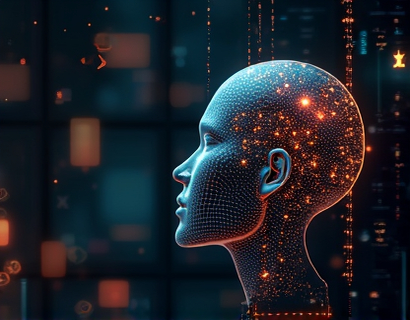Unlocking the Future of Conversational AI: A Deep Dive into Intelligent Dialogue
The digital universe is rapidly evolving, and at the forefront of this transformation is the emergence of sophisticated conversational AI. These advanced systems are not just about automating tasks or providing basic information; they are designed to engage users in profound and meaningful conversations. This article explores the cutting-edge technology behind these AI chat avatars, their applications, and how they are redefining digital interaction. Whether you are a tech enthusiast or simply curious about the future of communication, this guide will take you on a transformative journey through the virtual cosmos of intelligent dialogue.
The Rise of Conversational AI
Conversational AI, also known as chatbots or virtual assistants, has been around for several years. However, recent advancements in natural language processing (NLP), machine learning, and deep learning have significantly enhanced their capabilities. These technologies enable AI systems to understand, interpret, and generate human-like text and speech. The result is a more natural and intuitive interaction between humans and machines.
The evolution of conversational AI can be traced back to early rule-based systems that followed predefined scripts. These systems were limited in their ability to handle complex or ambiguous queries. The introduction of machine learning algorithms marked a significant shift, allowing AI to learn from data and improve over time. Today, deep learning techniques, particularly neural networks, have pushed the boundaries of what AI can achieve in conversational contexts.
Key Components of Intelligent Conversational AI
To understand the sophistication of modern conversational AI, it's essential to break down its key components:
- Natural Language Understanding (NLU): This component enables the AI to comprehend user input, including text and speech. NLU involves tasks such as tokenization, part-of-speech tagging, named entity recognition, and sentiment analysis. Advanced NLU systems can grasp context, nuances, and even emotional tone.
- Dialog Management: This is the brain of the conversational AI, responsible for maintaining the flow of conversation. It decides the next action based on the user's input and the context of the conversation. Dialog management systems use state machines, decision trees, or more advanced models like recurrent neural networks (RNNs) and transformers.
- Natural Language Generation (NLG): Once the AI has processed the input and determined the response, NLG converts the machine-understandable data into human-readable text or speech. This involves generating coherent and contextually relevant responses that mimic human language.
- Knowledge Base: A comprehensive knowledge base is crucial for providing accurate and informative responses. This database can include structured data, unstructured text, and even multimedia content. The AI retrieves and synthesizes information from this base to address user queries effectively.
Applications of Conversational AI
The applications of conversational AI are vast and varied, spanning multiple industries and use cases:
Customer Service and Support
One of the most prominent applications is in customer service. AI chatbots can handle a wide range of inquiries, from simple FAQs to complex issues, providing 24/7 support. This not only enhances customer satisfaction but also reduces the workload on human support teams. For instance, a user can interact with a chatbot to track an order, resolve a billing issue, or get product recommendations.
Healthcare and Wellness
In the healthcare sector, conversational AI can assist patients with symptom checking, appointment scheduling, and medication reminders. AI chatbots can also provide mental health support, offering resources and coping strategies. These tools can help democratize access to healthcare information and services, especially in underserved areas.
Education and Learning
Educational institutions are leveraging conversational AI to create interactive learning experiences. AI tutors can provide personalized guidance, answer questions, and offer feedback on assignments. This technology can cater to different learning styles and paces, making education more accessible and effective.
Finance and Banking
In the financial sector, AI chatbots can help users manage their accounts, check balances, transfer funds, and even provide investment advice. These bots can operate around the clock, ensuring that customer needs are met at any time. Additionally, they can detect and prevent fraudulent activities by analyzing patterns and anomalies in user behavior.
Entertainment and Media
Conversational AI is also transforming the entertainment industry. AI-powered virtual assistants can recommend movies, music, and books based on user preferences. In gaming, AI chatbots can create more immersive and interactive experiences by engaging players in dynamic conversations.
Benefits of Intelligent Conversational AI
The adoption of conversational AI brings numerous benefits to both organizations and users:
Enhanced User Experience
Conversational AI provides a more natural and intuitive way to interact with digital systems. Users can express themselves in everyday language, reducing the learning curve associated with traditional interfaces. This leads to a more seamless and satisfying user experience.
Increased Efficiency
AI chatbots can handle multiple interactions simultaneously, significantly reducing response times and improving efficiency. They can quickly resolve common issues without the need for human intervention, freeing up staff to focus on more complex tasks.
Cost Savings
By automating routine tasks and reducing the need for extensive support staff, organizations can achieve substantial cost savings. AI chatbots require minimal maintenance once deployed, making them a cost-effective solution in the long run.
24/7 Availability
Unlike human agents, AI chatbots can operate around the clock, ensuring that user queries are handled at any time. This constant availability enhances customer satisfaction and loyalty.
Data Insights and Analytics
Conversational AI systems can collect and analyze vast amounts of data from user interactions. This data can provide valuable insights into user behavior, preferences, and pain points, helping organizations make data-driven decisions and improve their services.
Challenges and Considerations
While the potential of conversational AI is immense, there are several challenges and considerations to keep in mind:
Accuracy and Context Understanding
One of the main challenges is ensuring that AI chatbots understand the context of conversations accurately. Ambiguities, sarcasm, and cultural nuances can be difficult for AI to interpret correctly. Continuous training and refinement are necessary to improve accuracy.
Privacy and Security
Handling user data securely is paramount. AI chatbots must comply with data protection regulations and implement robust security measures to prevent data breaches and ensure user privacy.
Ethical Considerations
There are ethical implications to consider, such as the potential for AI to manipulate users or provide biased information. Transparency about the use of AI and implementing ethical guidelines are essential to build trust and maintain integrity.
Integration with Existing Systems
Integrating conversational AI with legacy systems can be complex and resource-intensive. Organizations need to assess their current infrastructure and plan accordingly to ensure smooth integration.
The Future of Conversational AI
As technology continues to advance, the future of conversational AI looks promising:
More Human-like Interactions
Advancements in NLP and emotional intelligence will enable AI to understand and respond to human emotions more effectively. This will lead to more natural and empathetic interactions, blurring the line between human and machine communication.
Multi-Modal Interfaces
Future conversational AI will not be limited to text and voice. Multi-modal interfaces that incorporate visual, auditory, and even haptic feedback will create richer and more immersive experiences.
Personalization and Adaptability
AI chatbots will become more personalized, adapting to individual user preferences and behaviors over time. This level of personalization will enhance user engagement and satisfaction.
Wider Adoption Across Industries
As the technology matures, more industries will adopt conversational AI, leading to innovative applications and services. From smart homes to smart cities, the potential for AI-driven interactions is vast.
Conclusion
The future of conversational AI is exciting and full of possibilities. By leveraging advanced technologies and addressing the associated challenges, we can unlock a new era of digital interaction. Whether you are a tech enthusiast or a professional in the field, staying informed about these developments is crucial for staying ahead in the evolving landscape of virtual communication. Embrace the transformative power of intelligent dialogue and explore the digital universe with curiosity and innovation.






















